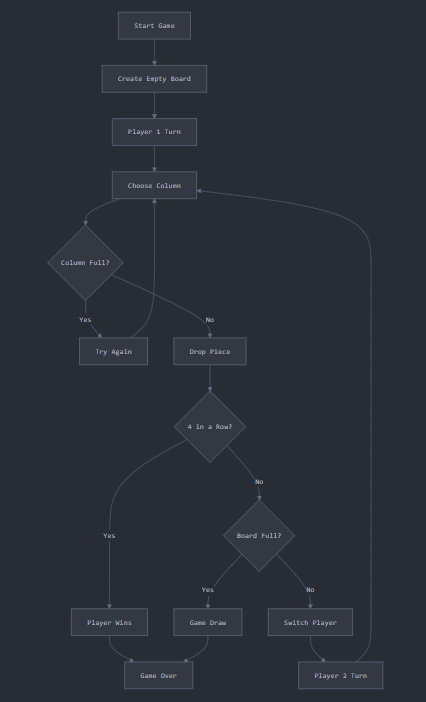What is Connect 4 Algorithm Design?
Connect 4 algorithm design is about creating the game logic - the rules, win detection, and player management that make the game work. This means:
- How pieces fall into the lowest available position
- Detecting when a player connects four pieces in a row
- Managing player turns and game state
- Validating moves before they happen
The Big Picture: Algorithms are the step-by-step instructions that make games fair, fun, and functional.
Algorithm Flow Overview
Before diving into the details, let's see the complete Connect 4 algorithm flow:

The Algorithm Stack: Data Structures, Logic, Validation
Data Structure: The Game Board
The board is a 2D array that represents our playing field:
// 2D array structure tells us what's in each position
let board = [
[null, null, null, null, null, null, null], // Row 0 (top)
[null, null, null, null, null, null, null], // Row 1
[null, null, null, null, null, null, null], // Row 2
[null, null, null, null, null, null, null], // Row 3
[null, null, null, null, null, null, null], // Row 4
[null, null, 'red', null, null, null, null] // Row 5 (bottom)
];
Key Principle: Arrays create the foundation. Each position can hold null (empty), 'red', or 'yellow'.
Algorithm 1: Finding the Drop Position
function getDropRow(board, col) {
// Start from bottom and work up
for (let row = 5; row >= 0; row--) {
if (board[row][col] === null) {
return row; // Found empty spot
}
}
return -1; // Column is full
}
Key Principle: Gravity simulation - pieces always fall to the lowest available position.
Try It Yourself
Click a column to see where the piece would fall:
Algorithm 2: Win Detection Logic
function checkWin(board, row, col) {
const color = board[row][col];
const directions = [
[1, 0], // vertical ↓
[0, 1], // horizontal →
[1, 1], // diagonal ↘
[1, -1] // diagonal ↙
];
for (const [deltaRow, deltaCol] of directions) {
let count = 1; // count current piece
// Check both directions from current piece
for (const direction of [-1, 1]) {
let r = row + deltaRow * direction;
let c = col + deltaCol * direction;
while (r >= 0 && r < 6 && c >= 0 && c < 7 &&
board[r][c] === color) {
count++;
r += deltaRow * direction;
c += deltaCol * direction;
}
}
if (count >= 4) return true;
}
return false;
}
Key Concepts: Direction vectors, boundary checking, pattern matching
Core Algorithm Skills You'll Learn
Skill 1: State Management
Learning Goal: Keep track of game data and player turns
Try It Yourself
Current Player: Red
// State management connects all pieces together
class GameState {
constructor() {
this.board = this.createEmptyBoard();
this.currentPlayer = 'red';
this.gameOver = false;
}
makeMove(col) {
const row = this.getDropRow(col);
if (row >= 0) {
this.board[row][col] = this.currentPlayer;
if (this.checkWin(row, col)) {
this.gameOver = true;
return `${this.currentPlayer} wins!`;
}
this.switchPlayer();
}
return null;
}
}
Skill 2: Win Detection in Action
Learning Goal: Detect four-in-a-row patterns immediately after each move
Try to Win!
Current Player: Red
Why This Matters: The game must instantly recognize victory conditions and end appropriately.
Quick Check
What's the most important concept you learned about Connect 4 algorithms?
What You Just Learned
Skill 1: Using 2D arrays to represent game boards
Skill 2: Implementing gravity with bottom-up searching
Skill 3: Detecting patterns using direction vectors
Key Takeaways
- Data Structures Matter: 2D arrays perfectly model grid-based games
- Algorithm Efficiency: Check wins only after moves, not constantly
- Edge Cases: Always validate bounds and handle full columns
- State Management: Keep track of whose turn it is and game status
- Pattern Recognition: Use mathematical approaches to detect wins
Related Resources
- MDN: JavaScript Arrays
- Algorithm Design Manual
- Game Programming Patterns
Duration: ~60 minutes | Audience: CS students learning algorithms | Meta-Goal: Understanding game logic through hands-on interaction
